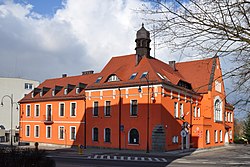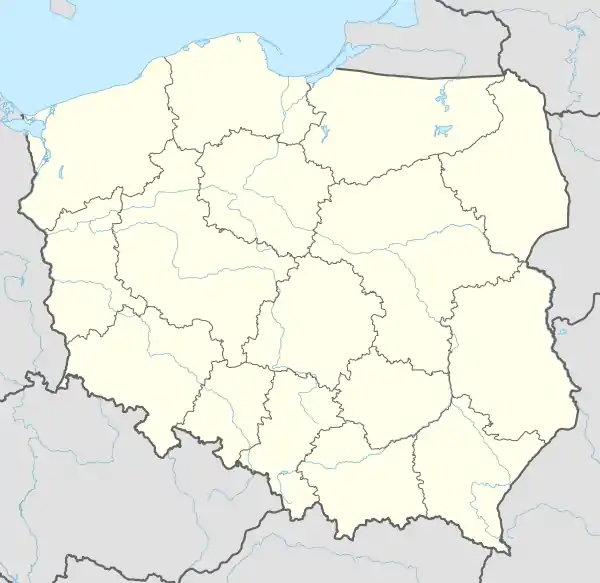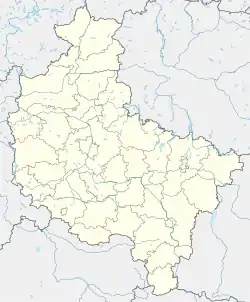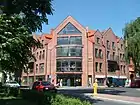Trzcianka
Trzcianka [ˈtʂt͡ɕaŋka] (German: Schönlanke) is a town in the Greater Poland region in Poland. Since 1999, it has been part of the Greater Poland Voivodeship and Czarnków-Trzcianka County. From 1975–1998, it was located in the Piła Voivodeship. In May 2007, Trzcianka had 17,131 inhabitants.
Trzcianka | |
|---|---|
 Town hall | |
 Flag  Coat of arms | |
 Trzcianka  Trzcianka | |
| Coordinates: 53°3′N 16°28′E | |
| Country | |
| Voivodeship | Greater Poland |
| County | Czarnków-Trzcianka |
| Gmina | Trzcianka |
| Founded | 13th century |
| First mentioned | 1245 |
| Town rights | 1731 |
| Area | |
| • Total | 18.25 km2 (7.05 sq mi) |
| Population (2006) | |
| • Total | 16,756 |
| • Density | 920/km2 (2,400/sq mi) |
| Time zone | UTC+1 (CET) |
| • Summer (DST) | UTC+2 (CEST) |
| Postal code | 64-980 |
| Vehicle registration | PCT |
| Website | http://www.trzcianka.pl |
Trzcianka is located on the Trzcianka River, and three lakes, Sarcze, Okunie and Długie, are located within the town limits.
History
_m.bocz..jpg.webp)
The settlement, initially named Rozdróżka, was probably founded in the 13th century.[1] It was located on a trade route which connected Poznań and Kołobrzeg.[1] Rozdróżka was mentioned in a document from 1245, when Duke Boleslaus V of Poland gave the land in the Noteć river valley, along with three villages (Biała, Gulcz, and Rozdróżka) to a Polish nobleman named Sędziwój of Czarnków. The new name of these three combined villages was Trzciana Łąka, as it appeared for the first time in 1565, and it was subsequently changed to Trzcianka in the 17th century.
Trzciana Łąka was a private village of Polish nobility, administratively located in the Poznań County in the Poznań Voivodeship in the Greater Poland Province of the Polish Crown,[2] and in the 17th century it became a settlement of weavers and clothiers.[1] It was owned by the Gembicki family, thanks to which it developed, and in 1679 Andrzej Gembicki referred to it as a town.[1] It was granted town rights by King Augustus II the Strong in 1731.[1] In the mid-18th century it was owned by magnate Stanisław Poniatowski, father of the last Polish King Stanisław August Poniatowski, and the Poniatowskis' Ciołek coat of arms is the town's coat of arms since.[1] In the 18th century Trzcianka was one of the leading clothmaking centers in Greater Poland, however, after the late 18th-century Partitions of Poland and the annexation of the town by Prussia, the local economy collapsed.[1]
In 1807 the town was regained by Poles and included within the short-lived Duchy of Warsaw, in 1815 it was re-annexed by Prussia, and hence became also part of Germany. In the final months of World War II, Soviet troops marching towards Berlin from the east entered the town on 27 January 1945. In that course, about 500 people committed suicide.[3] Following the war the abandoned town was eventually restored to Poland.[1]
Culture
There is a local historic museum (Muzeum Ziemi Nadnoteckiej) in Trzcianka.
Notable people
- Michael Solomon Alexander, first Protestant Bishop of Jerusalem was born here
- Andrzej Aumiller (born 1947), Polish politician, and Member of Parliament was born here
- Krystian Feciuch (born 1989), Polish footballer
- Hubert Mickley (1918–1944), Wehrmacht officer
- Max Raphael (1889–1952), German-American art historian of art of the Upper
- Gustav Ferdinand Mehler (1835-1895), German-Mathematician.
Gallery
 Długie Lake
Długie Lake Beach on Sarcze Lake
Beach on Sarcze Lake Shopping mall
Shopping mall Art Nouveau Pedagogical Library
Art Nouveau Pedagogical Library
References
- "Rys historyczny". Serwis Miasta i Gminy Trzcianka (in Polish). Retrieved 8 September 2020.
- Atlas historyczny Polski. Wielkopolska w drugiej połowie XVI wieku. Część I. Mapy, plany, Instytut Historii Polskiej Akademii Nauk, Warszawa, 2017, p. 1a (in Polish)
- Lakotta, Beate (2005-03-05). "Tief vergraben, nicht dran rühren" (in German). SPON. Retrieved 2010-08-16.
External links
- Official page (English, German, Polish)
- Unofficial site of the city ( Polish)
| Wikimedia Commons has media related to Trzcianka. |
